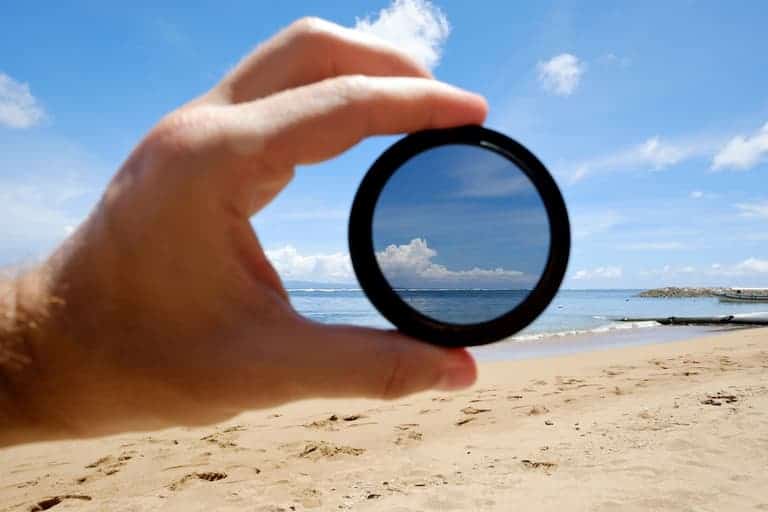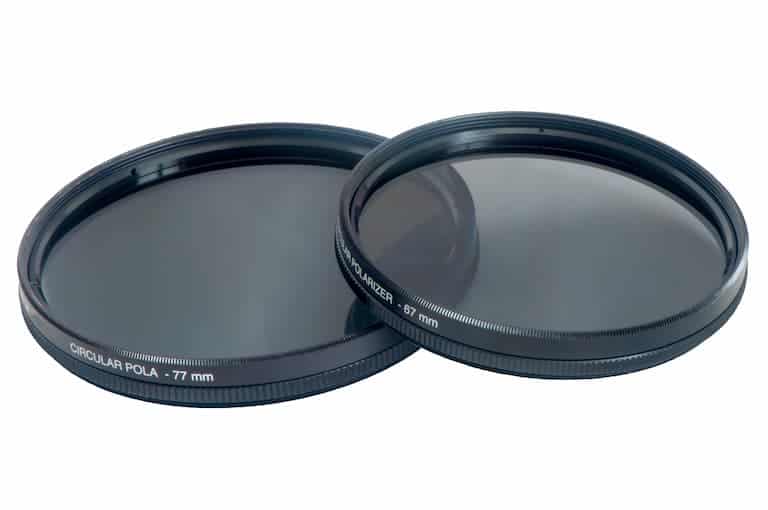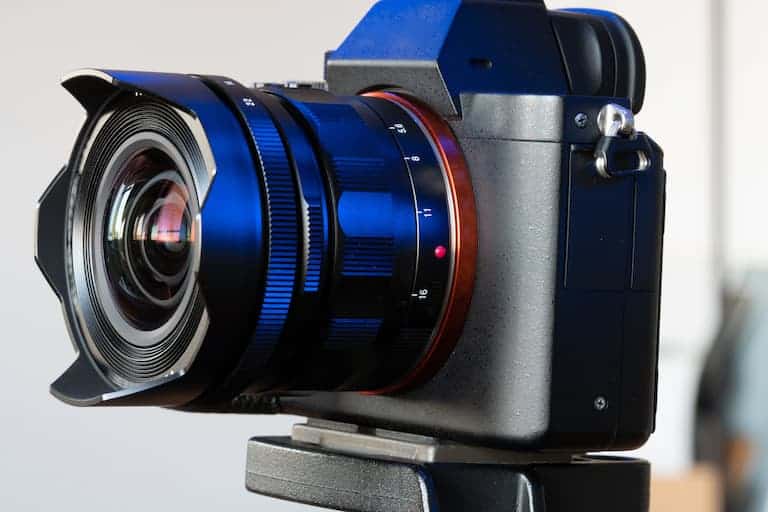There are many tools available for photographers to get their perfect pictures. Circular polarizers are great for removing any light glares and reflections while simultaneously enhancing the colors of the photo.
The best circular polarizer for wide angle lenses is the LEE100 Polarizer. If you’re on a budget, the best option is the Hoya Slim Circular Polarizing Filter. You should purchase one that’s marketed as ‘slim’ and that matches the diameter of your lens.
In the rest of this article, we’ll discuss the best circular polarizers available, the perks of using a circular polarizer, and how to use one with a wide-angle lens effectively.
Table of Contents
The Best Circular Polarizers
Here are some of our top recommendations from Amazon.com for circular polarizers for wide-angle lenses. These recommendations cover slim polarizers, budget, and high-end.
Slim Circular Polarizers
-
 $112.90Buy Now
$112.90Buy NowThis is a high-quality and middle-range budget circular polarizer designed with a slim fit, perfect for your wide-angle lens. There are plenty of size options available for every lens size.
We earn a commission if you make a purchase, at no additional cost to you.
03/05/2024 06:50 pm GMT -
 $43.99Buy Now
$43.99Buy NowThis slim circular polarizer is less expensive, but still considered a high-quality option. It’s easy to rotate and is made of extra-tough aluminum. There are also an array of size options from 37mm to 90mm.
We earn a commission if you make a purchase, at no additional cost to you.
03/05/2024 05:29 pm GMT -
 $123.90Buy Now
$123.90Buy NowThis moderately priced circular polarizer also comes in a slim design with extensive size options. It has a great neutral tone and is easy to screw onto the camera lens.
We earn a commission if you make a purchase, at no additional cost to you.
03/06/2024 12:01 pm GMT
Budget Circular Polarizers
-
 $65.39Buy Now
$65.39Buy NowThis is a relatively inexpensive circular polarizer. The high quality is great value for money. It has excellent image quality and many size options for your lenses. However, the light transmission isn’t as good as other polarizers.
We earn a commission if you make a purchase, at no additional cost to you.
03/06/2024 12:55 pm GMT -
 $19.99Buy Now
$19.99Buy NowThis is another affordable polarizer that most people seem to like. There are a variety of sizes, from 30mm to 82mm. The only drawback of this lens is that it has a bit of a blue-ish hue.
We earn a commission if you make a purchase, at no additional cost to you.
03/06/2024 01:21 pm GMT -
 $13.70Buy Now
$13.70Buy NowIt's hard to get much cheaper than this circular polarizer. Though this polarizer doesn’t have some of the other great benefits of more expensive ones, it’s a great place to start if you just want to test the waters.
We earn a commission if you make a purchase, at no additional cost to you.
03/05/2024 09:21 pm GMT
High-End Circular Polarizers
-
 $322.50Buy Now
$322.50Buy NowThis is a very high-end and expensive circular polarizer but offers some amazing perks. The image quality is top of the line, and the 105mm diameter allows it to be used for many of your lenses. The filter is also resistant to water, dirt, and smudges.
We earn a commission if you make a purchase, at no additional cost to you.
03/05/2024 09:11 pm GMT -
 $149.00Buy Now
$149.00Buy NowAlthough a bit pricier than others, this circular polarizer is a very advanced option. It has controlled light transmission, and clear crown glass, and is one of the more color-neutral options.
We earn a commission if you make a purchase, at no additional cost to you.
03/06/2024 03:01 pm GMT -
 $199.90Buy Now
$199.90Buy NowOne of the more expensive polarizers from the Hoya brand, this circular polarizer is smooth and extra tough, great for protecting and cleaning the filter. The light transmission is an incredible 92%. It also offers a limited warranty when purchased from USA Authorized Retailers.
We earn a commission if you make a purchase, at no additional cost to you.
03/05/2024 08:32 pm GMT
What Is a Circular Polarizer and What Does It Do?
Sometimes the light in your photographs will be glaring a bit too much, or the colors will look a bit more faded than they do in real life.
A circular polarizer is a filter lens you place over your camera lens that helps correct glares and reflections, improves the color saturation and vibrancy, and reduces any haziness.
Too much light can often negate the details of your shot. Using a circular polarizer can bring out the more minor details and make your photo much more vivid.

How Circular Polarizers Work
Circular polarizers are made of two components – a lens and an attachment piece that connects to your camera lens. After it attaches, the circular polarizer will rotate to give it the polarization effect.
You can manually turn the polarizer until you’re satisfied with how it looks through the camera. Make sure to test out a couple of photos to see how the polarizer affects the shot. Depending on the surrounding environment and lighting, the effects can be extreme or subtle.
When To Use a Circular Polarizer
Circular polarizers can be used in any setting, but are mainly used for landscape or city shots.
They’re well-loved for shooting natural objects such as bodies of water, trees, skies, and foliage. By reducing the glare of the light and enhancing the color, they can add some amazing depth to your shot.
Cities are also a great place to use circular polarizers. Photographing the glass-like surface of buildings and the reflectivity of paint and cars is very different with a polarizing lens. You’ll capture more details, color, and structure in all your shots.
Are All Polarizers the Same?
The search for finding the perfect polarizer can be tricky, especially if you’re new to photography.
Not all polarizers are the same. In fact, there are two kinds of general polarizers – circular and linear. Linear polarizers are for manual focus photography or video, and circular polarizers are for DSLRs and autofocus cameras. You most likely want to buy a circular polarizer.
Circular polarizers more or less do the same thing to your photos. However, they may also have some subtle differences when it comes to quality and other distinctions in their results.
More expensive circular polarizers will generally have a more noticeable effect on your photos. There may also be more vignetting in some polarizers than others. You may wish to try a couple out in the stores to determine if they suit your photography preferences.

What Size Circular Polarizer Do I Need?
Circular polarizers aren’t all the same size because they aren’t one-size-fits-all.
The size of the circular polarizer you need will depend on the thread diameter of your camera lens. This means that the circular polarizer won’t work with all of your lenses, only the ones of that specific size. You need to determine which lens you want to use the polarizer with and get that size.
If you’re hoping to use the circular polarizer with a wide-angle lens, you need to get one that matches that size. Therefore, if the diameter of your wide-angle lens is 62mm, then you should purchase a 62mm circular polarizer.
Issues With Circular Polarizers and Wide Angle Lenses
Circular polarizers don’t always work well with wide-angle lenses. This isn’t to say they don’t work, but there are some problems that might arise.
Wide-angle lenses take in an extremely large area. If a significant portion of this area is the same color, the polarizing lens can make some parts look a lot darker than others. It’s sometimes difficult to see this when you’re taking the photos, but it’ll certainly be noticeable once you get home and upload your photos.
The vignette becomes super noticeable on wide-angle lens photos, even making the top of the photo almost black. Some people like this effect, but others don’t. The gradient effect is often too much for the image and looks like a bad filter.
Additionally, circular polarizing lenses are thick and create more vignetting around the corners and edges. One fix to this problem is to make ‘slim’ filters. These are more expensive, but they may prevent some of the more noticeable vignetting.
Although there are a few problems that go along with using wide-angle lenses and circular polarizers together, there are some solutions, such as buying a slim polarizer.

Things You Should Consider When Buying a Circular Polarizer
There are some general things to watch out for when buying a circular polarizer filter:
- Some wide-angle lenses aren’t compatible with circular polarizers: Some wide-angle lenses aren’t compatible with the screw-in setting of circular polarizing filters. Some of them also have a curved front that doesn’t allow for a lens. Check your wide-angle lens before purchasing to make sure that it’ll allow for a circular polarizer.
- High transmission filters have less polarization: When you purchase a high transmission filter, there’ll be less polarization because they let more light through. This isn’t necessarily a bad thing – the more control your lens has over polarization, the better.
- 1.2 to 1.4 stop transmission filters are generally better: Cheaper circular polarizers will be around 2 stops, while expensive, better quality ones will be 1.2 to 1.4.
- Buy a polarizer of the same diameter or greater: It’s best to purchase a circular polarizer that’s the same size as your lens thread diameter. However, you can also purchase a size up and use a step-up ring to fit it correctly.
How To Use a Circular Polarizer
A circular polarizer should easily attach to your camera lens. You should attach it when you’re ready to begin shooting.
It’s helpful to set your focus before you begin to adjust the polarizer. Otherwise, the setting you have fixed the polarizer to will change as you focus the shot and rotate your lens. Then you’ll have to adjust the polarizer a second time.
The polarizer will have a manual rotation ability, allowing you to adjust it to your shot. Turn it slowly as you look through your camera viewfinder or LCD as you turn it to find the optimal setting. You can also take some practice shots just to make sure the polarizer is doing what you want.
The level of light transmission and color saturation will change as you rotate your lens. The best setting will change with every shot, depending on the lighting, the scenery, and your position to the light source. For every new shot, you may need to re-adjust.
It’s best to photograph at a 90-degree angle to the sun. Shooting when the sun is either directly behind or in front of you isn’t recommended. You’ll either lose the effect of the filter or create unwanted lens flares.

It’ll help to practice using a circular polarizer in different locations and settings. You can test out the adjustment settings to determine what peak polarization looks like. It’ll be noticeable because the light reflections will disappear, and the color will pop. The entire photo should have enhanced detail and structure.
Here are some tips for taking photos with a circular polarizer lens:
- Take photos at a 90° angle from the sun: Circular polarizers work best when taking a shot at a 90° angle from the sun. If the light is directly on the subject, the polarization effect won’t work as well.
- When using in a shadowy area, you may lose detail: Avoid taking photos in areas with not enough light. The polarization will cause details to be lost.
- Don’t take photos towards the light source: If you take a photo of the light source directly, there’s a high possibility of lens flares. This is because of the additional glass layers reflecting the light.
- Polarizers aren’t consistent with your photo: Polarizers don’t have the same exact effect on every section of your photo. Some parts of the photo may be lighter or darker, more or less vibrant. This can sometimes look odd, especially with wide-angle lenses. Be wary of the varying effects on your photos as you take them.
- Exposure is lost when using the polarizer: Polarizers naturally cause your photos to lose about 1 to 3 stops of light, causing the exposure of your shot to decrease. Keep this in mind as you shoot, especially if the lighting isn’t optimal. You don’t want your shots to be too dark.
Conclusion
Circular polarizers are an amazing tool for enhancing your photo’s saturation and getting rid of those annoying light glares and reflections. Although they can be tricky to use with wide-angle lenses, it’s certainly possible.
Slim circular polarizers work best with wide-angle lenses, but you can use other types if you don’t mind having some stark color and light differences in your photos.
Whatever you decide, make sure you test out the polarizer on your shots before settling on the setting. This way, you can make sure you’ll be happy with the end results.









